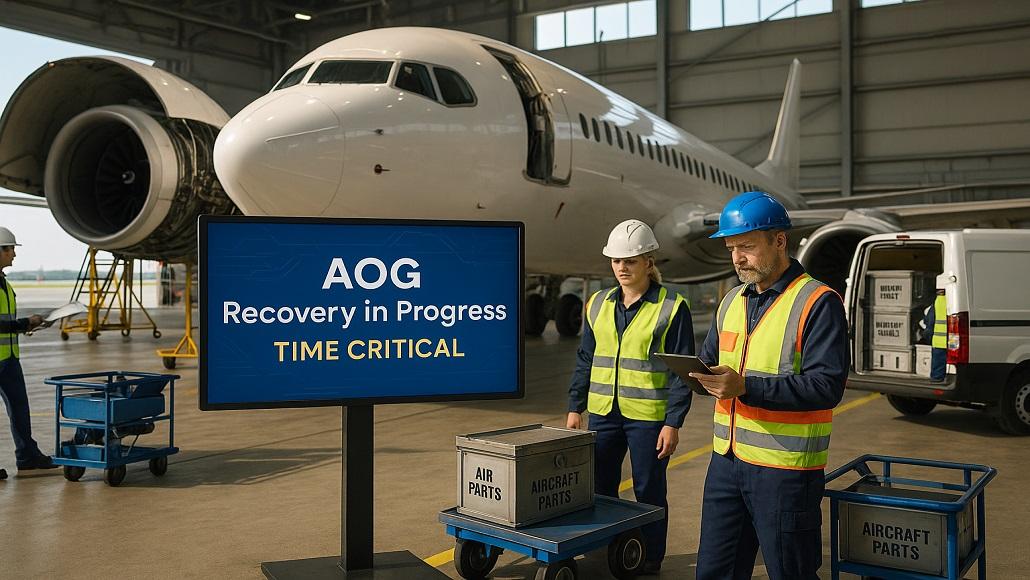In the rapidly poised world of aviation, the term aircraft-on-ground (AOG) happens to invoke a sense of urgency, which is indeed palpable throughout the industry. When an aircraft is grounded because of maintenance issues, part failures, or any other operational disruption, every minute makes a difference. The logistics of AOG recovery are complexly woven into the fabric of aviation management and happen to represent a very crucial challenge for airlines, maintenance providers, and logistics teams. Let us delve into the complexities of AOG recovery logistics by way of examining the various strategies that are rolled out in order to minimize any sort of downtime and other implications for functional efficiency as well as customer satisfaction.
What are aircraft-on-ground – AOG situations?
Aircraft-on-ground situations crop up when an aircraft is unable to function because of technical malfunction, requirements of maintenance, or even a dearth of essential parts. These occurrences can take place at any point within the flight schedule, thereby leading to prominent disruptions in airline functions. The financial implications are also quite substantial. According to the International Air Transport Association (IATA), the expenditure of an AOG situation can go on to reach thousands of dollars every hour in terms of lost revenues, functional penalties, and also reputational damages. In a sector where punctuality and dependence are at the fore, the stakes are indeed very high. Airlines function on tight schedules, and passengers anticipate timely departures along with arrivals. When an aircraft gets grounded, the barriers extend beyond just repairing the aircraft but also include managing passenger expectations, coordinating with the logistics, and making sure that the aircraft is returned to service as soon as possible.
AOG recovery and logistics
The logistics that surround AOG recovery happen to involve various approaches, which include fast response teams, efficient supply chain management, and accurate communication strategies. When an aircraft gets grounded, the first and necessary step is to evaluate the situation and also determine the reason for the delay. Maintenance teams along with engineers get dispatched to assess the aircraft, diagnose any kind of problem, and also come up with the recovery plan. Once the diagnosis is made, the logistics of sourcing parts as well as equipment become very crucial. Aircraft components, more often than not, need specialized parts that may not be readily available within the vicinity of an airport. Hence, the airlines have to establish partnerships along with suppliers as well as logistics providers to make sure that the essential parts can be sourced as quickly as possible. In certain scenarios, airlines may as well utilize an AOG stock of often-needed parts that are kept at strategic locations in order to expedite any sort of repairs. Besides this, maintaining a comprehensive inventory management system is also very critical for efficient EOG recovery. By way of monitoring inventory levels and also the usage patterns, airlines can quickly make use of their supply chain processes and also ensure that crucial components are available when they are required. This kind of proactive approach decreases the likelihood of prolonged AOG scenarios and also reduces the effect on operations.
Technology along with AOG recovery
In the digital age that we live in today, technology happens to play a very critical role when it comes to elevating the logistics of AOG recovery. Airlines, along with maintenance teams, are increasingly utilizing advanced software systems in order to make their communication seamless, monitor the status when it comes to repairs, and also manage the inventory levels in an effective way. Real-time data analytics helps with swift decision-making by enabling the teams to respond in a very quick manner to any sort of emerging AOG situation.
For example, maintenance, repair, and overhaul—MRO software solutions offer an overall visibility into an aircraft’s maintenance history along with its components. By way of making use of these tools, teams can identify certain potential issues much before they escalate into AOG events, thereby helping with proactive maintenance scheduling. Moreover, mobile applications have also gone on to transform the AOG recovery process by enabling the technician as well as logistics workers to communicate in a very seamless manner. Real-time updates in terms of part availability, status of the repair, and also the progress tracking elevate the partnership among the teams and hence decrease the delays in recovery efforts.
The financial effect of AOG scenarios
The financial repercussions when it comes to AOG situations go beyond the urgent repair costs. Airlines experience direct loss when it comes to ticket refunds, compensation for affected passengers, and also lost revenue, which comes from delayed flights. As per a report by Boeing, the expenditures associated with AOG events can average somewhere between $10,000 and $10,000-$30,000 every hour, depending upon the aircraft type as well as the operations scenario. Moreover, the indirect cost that is associated with AOG situations can also be very substantial.
Airlines may also face reputational damage because of customer dissatisfaction, thereby leading to decreased loyalty towards the brand and also future bookings. In a sector that has very steep competition, maintaining a reputation in terms of dependability is very essential for long-term success.
In order to lessen such risks, airlines have to invest in comprehensive AOG recovery strategies, which happen to prioritize fast response as well as effective logistics management. By way of elevating functional efficiency along with minimizing the downtime, airlines can go ahead and safeguard their financial performance and, at the same time, also take care of their customers’ satisfaction.
Case studies related to AOG recovery
There are many airlines that have successfully executed strategies in order to elevate their AOG recovery processes. For instance, carriers such as Delta Airlines and Lufthansa have gone on to establish dedicated AOG response teams, which are equipped to handle certain emergency situations in a very prompt way. These teams work in partnership with logistics partners, suppliers, and also maintenance crews to make sure that the aircraft are returned to service as soon as possible. There is another notable example, which is the usage of predictive analytics by airlines in order to predict potential AOG events that are based on maintenance patterns as well as historical data. By way of identifying trends and executing the preventive steps, carriers can decrease the occurrence of AOG scenarios and hence, in a way, enhance their operational dependability.
In addition to this, collaboration with logistics providers that specialize in urgent aircraft parts delivery can drastically decrease the response times. These partnerships help the airlines to quickly get access to parts that they need, thereby making sure that the repairs can be completed without any delays.
Lastly
The logistics when it comes to aircraft-on-ground – AOG recovery are indeed very necessary for maintenance of operational efficiency along with customer satisfaction within the aviation sector. As aircraft become growingly sophisticated and demand when it comes to punctuality rises, airlines have to prioritize the development of strong AOG recovery strategies, which make utmost use of technology, elevate the inventory management, and also foster partnerships with logistics partners. By way of investing in these strategies, airlines can reduce the effect of AOG scenarios on their functions and also protect their financial stability. As the sector goes on to evolve in a very fast-changing environment, the capacity to respond quickly and also efficiently to AOG scenarios is going to be the defining factor in any airline’s long-term success.
It is well to be noted that in a world where seconds matter, the logistics in terms of AOG happen to represent a very crucial barrier as well as an opportunity for airlines in order to go ahead and demonstrate their commitment to dependability, effectiveness, efficiency, and customer satisfaction. The significance of proactive planning along with real-time responsiveness as well as partnership is going to be paramount when it comes to shaping the future of aviation logistics and also making sure that the skies remain dependable for passengers as well as air cargo operations.



























